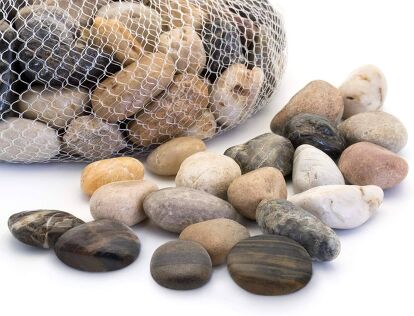Exploring The Riparium: A New Kind of Planted Tank

Also known as a “Riverbank Aquarium,” the Riparium is growing in popularity. Let’s go over the basics of this new planted tank trend and learn if it’s the right hobby for you.
If you’re an experienced aquarium hobbyist well versed in the art of cultivating aquarium plants, you may be interested in learning about a new type of planted tank – the riparium. Ripariums are great for beginners as well as experts because the plants are easier to grow but there are still plenty of options for customization. If you are curious to learn more about ripariums, this article is the perfect place for you to start.
What is a Riparium?
There is no exact definition of the word “riparium,” though it is generally used to describe a tank that recreates shoreline conditions. For example, a tank setup to mimic the shoreline of a stream or river would constitute a riparium (also known as a “riverbed aquarium”). These tanks are typically decorated with marginal plants – that is, plants that are rooted in an aquatic environment but produce leaves which grow above the surface of the water. These plants must be adapted to low oxygen levels because they typically grow in boggy or muddy substrates. Marginal plants must also be adaptable to changing water levels since they grow at the water’s edge.
There are a great many benefits associated with ripariums versus traditional planted tanks. For one thing, it can be difficult to balance the water conditions necessary to cultivate both live plants and aquarium fish. With ripariums, you can choose marginal plants which are usually much easier to grow. Another benefit of ripariums is that you do not need to worry about keeping oxygen levels in your tank high and you don’t even have to fill the tank completely with water. The downside of a riparium is that you will have to prune your plants to keep them from overgrowing the tank and you might have to take steps to prevent pests like aphids or spider mites.
Choosing the Best Plants for Ripariums
If you want to cultivate a thriving riparium, you need to be intentional about which kinds of plants you choose. There are three factors to consider when choosing your plants:
1. Adaptability to tank conditions
The ability of a plant to adapt to the conditions in your riparium is the most important factor to consider. The best plants for ripariums are those that adapt well to wet conditions – this includes plants that grow naturally along the edges of streams, rivers, and lakes. Plants must also be able to tolerate low oxygen levels and very wet soil. Some of the most adaptable aquarium plant species include Anubias, Cryptocoryne, Microsorum, and Echinodorus. Plants that tend to grow well in ponds may also be a good choice as long as they do not grow too large for the tank.
The plants you choose to cultivate in your riparium are completely up to you, but you would be wise to consider three tried-and-true combinations:
Umbrella sedges, or Cyperus plants, are used to growing in wet, marshy conditions and there are many different species to choose from. These factors make them a great choice for the riparium. These plants do particularly well when accented with carpeting plants. To use carpeting plants in your riparium, go with a hanging planter attached to a trellis that the plant can spread over. Tropical forest plants like Pilea and Spathiphyllum peace lilies are another great option because they are easy to cultivate and they offer great coloration and variety. Acorus sweetflag is a species that grows in bogs and marshes, so it will thrive in riparium conditions.
Cultivating a riparium is just like any other planted tank – you have to choose your species carefully to match your tank conditions. The more research you do before you set up your tank, the better off you’ll be able to help your riverbed aquarium flourish.
There’s plenty of variety with aquariums but one thing remains consistently the same- the fact that you need the right equipment and supplies for any kind of fish tank or a planted tank to thrive. Riparium is no different. If you are looking to create your own thriving riparium from scratch, you’ll need to create a perfect environment for the plants before you put them in the tank- and these are the must-have items for that.
Almost any kind of fish tank can work for a riparium – but this particular combines convenience and style in a way that is ideally suited for a planted tank. The acrylic is much lighter than glass, it’s also clearer- and 17 times stronger, so the advantages of this affordable material are easy to see. The wide and rectangular shape of this tank is also perfect for a riparium, as it will allow you to properly display your prized setup. This aquarium is available in sizes from 20 to 50 gallons – and any of these sizes can be a good choice for plants.
RoyalImports River Pebbles Rocks
Needless to say, these river pebbles are ideal for simulating the riverbed environment. They can be a great finishing touch to your riparium and the detail that brings everything together and creates a realistic setup. However, be warned: these can be hard to maintain if you have fish in the tank as well, and other types of substrate that are easier to clean (such as gravel) might be the more convenient option in this case.
Penn Plax Cascade Canister Aquarium Filter
While an internal filter might do a decent job keeping your riparium water clean, a high-quality canister filtration system is a much better choice. With the state of the art technology, this canister aquarium filter will make sure that the water is crystal clear and your gorgeous flora (and fauna) are thriving. This powerful little gadget can be used for ripariums that are up to 100 gallons.
Hygger Full Spectrum Aquarium Light
It’s important to choose the right light for the plants you plan on growing in your riparium- but for most, regular LED or fluorescent lights will do the trick. This full-spectrum LED light for aquariums is budget-friendly and easy to set up and gives fantastic results – the lights are ultra bright and there are three color modes to choose from.
Hygger 500 Watt Aquarium Heater
The temperature inside the riparium should be optimal both for the plants and the fish that live in it. The only way to achieve this is to have a high-quality submersible aquarium heater. This impressive model boasts a protective guard that prevents contact of flora and fauna with the heating element, auto-shutoff overheating protection, easy to use external IC temp controller, and memory function. It is suitable for 60 to 120 gallon tanks.
We are committed to finding, researching, and recommending the best products. We earn commissions from purchases you make using the retail links in our product reviews. Learn more about how this works.

Kate Barrington is the loving owner of two cats (Bagel and Munchkin) and a noisy herd of guinea pigs. Having grown up with golden retrievers, Kate has a great deal of experience with dogs but labels herself a lover of all pets. Having received a Bachelor's degree in English, Kate has combined her love for pets and her passion for writing to create her own freelance writing business, specializing in the pet niche.
More by Kate Barrington



























